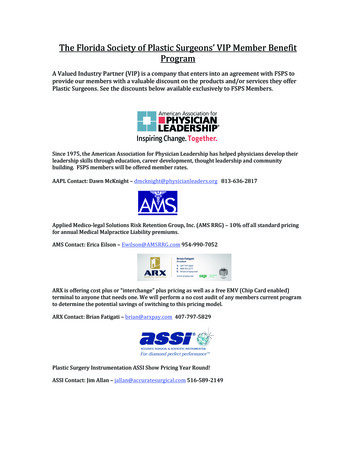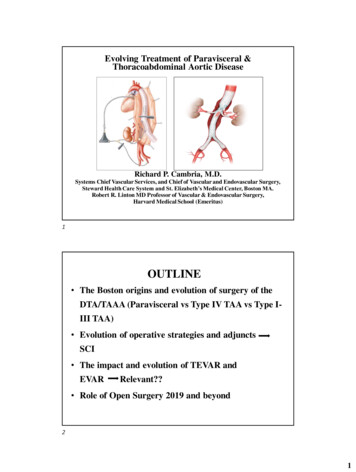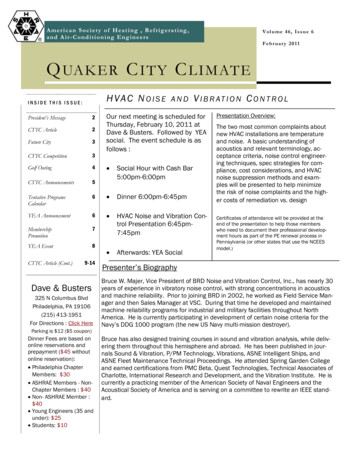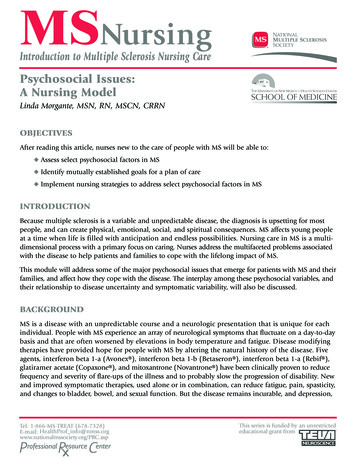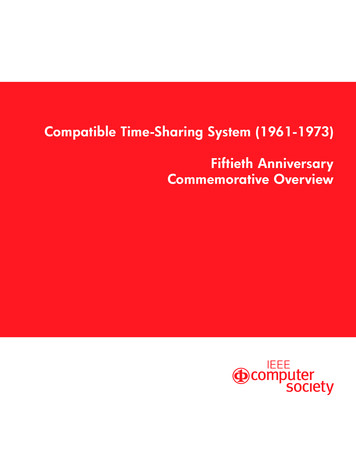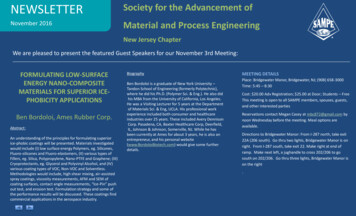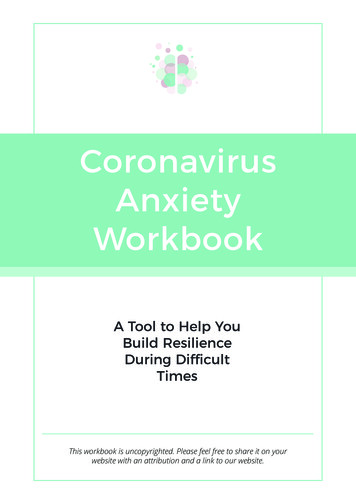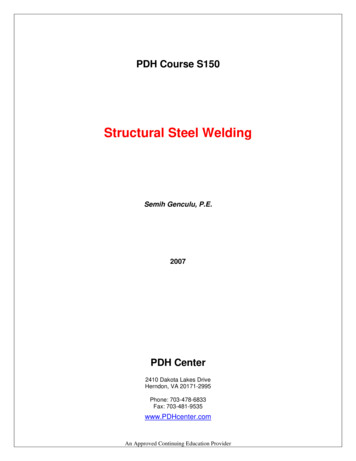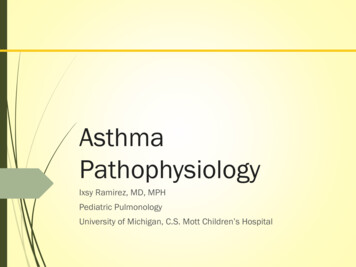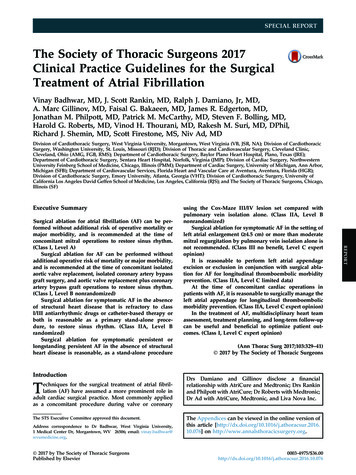
Transcription
SPECIAL REPORTThe Society of Thoracic Surgeons 2017Clinical Practice Guidelines for the SurgicalTreatment of Atrial FibrillationVinay Badhwar, MD, J. Scott Rankin, MD, Ralph J. Damiano, Jr, MD,A. Marc Gillinov, MD, Faisal G. Bakaeen, MD, James R. Edgerton, MD,Jonathan M. Philpott, MD, Patrick M. McCarthy, MD, Steven F. Bolling, MD,Harold G. Roberts, MD, Vinod H. Thourani, MD, Rakesh M. Suri, MD, DPhil,Richard J. Shemin, MD, Scott Firestone, MS, Niv Ad, MDDivision of Cardiothoracic Surgery, West Virginia University, Morgantown, West Virginia (VB, JSR, NA); Division of CardiothoracicSurgery, Washington University, St. Louis, Missouri (RJD); Division of Thoracic and Cardiovascular Surgery, Cleveland Clinic,Cleveland, Ohio (AMG, FGB, RMS); Department of Cardiothoracic Surgery, Baylor Plano Heart Hospital, Plano, Texas (JRE);Department of Cardiothoracic Surgery, Sentara Heart Hospital, Norfolk, Virginia (JMP); Division of Cardiac Surgery, NorthwesternUniversity Feinberg School of Medicine, Chicago, Illinois (PMM); Department of Cardiac Surgery, University of Michigan, Ann Arbor,Michigan (SFB); Department of Cardiovascular Services, Florida Heart and Vascular Care at Aventura, Aventura, Florida (HGR);Division of Cardiothoracic Surgery, Emory University, Atlanta, Georgia (VHT); Division of Cardiothoracic Surgery, University ofCalifornia Los Angeles David Geffen School of Medicine, Los Angeles, California (RJS); and The Society of Thoracic Surgeons, Chicago,Illinois (SF)Executive SummaryIntroductionechniques for the surgical treatment of atrial fibrillation (AF) have assumed a more prominent role inadult cardiac surgical practice. Most commonly appliedas a concomitant procedure during valve or coronaryTThe STS Executive Committee approved this document.Address correspondence to Dr Badhwar, West Virginia University,1 Medical Center Dr, Morgantown, WV 26506; email: vinay.badhwar@wvumedicine.org.Ó 2017 by The Society of Thoracic SurgeonsPublished by Elsevier(Ann Thorac Surg 2017;103:329–41)Ó 2017 by The Society of Thoracic SurgeonsDrs Damiano and Gillinov disclose a financialrelationship with AtriCure and Medtronic; Drs Rankinand Philpott with AtriCure; Dr Roberts with Medtronic;Dr Ad with AtriCure, Medtronic, and Liva Nova Inc.The Appendices can be viewed in the online version ofthis article 6] on http://www.annalsthoracicsurgery.org.0003-4975/ 0.076REPORTSurgical ablation for atrial fibrillation (AF) can be performed without additional risk of operative mortality ormajor morbidity, and is recommended at the time ofconcomitant mitral operations to restore sinus rhythm.(Class I, Level A)Surgical ablation for AF can be performed withoutadditional operative risk of mortality or major morbidity,and is recommended at the time of concomitant isolatedaortic valve replacement, isolated coronary artery bypassgraft surgery, and aortic valve replacement plus coronaryartery bypass graft operations to restore sinus rhythm.(Class I, Level B nonrandomized)Surgical ablation for symptomatic AF in the absenceof structural heart disease that is refractory to classI/III antiarrhythmic drugs or catheter-based therapy orboth is reasonable as a primary stand-alone procedure, to restore sinus rhythm. (Class IIA, Level Brandomized)Surgical ablation for symptomatic persistent orlongstanding persistent AF in the absence of structuralheart disease is reasonable, as a stand-alone procedureusing the Cox-Maze III/IV lesion set compared withpulmonary vein isolation alone. (Class IIA, Level Bnonrandomized)Surgical ablation for symptomatic AF in the setting ofleft atrial enlargement (‡4.5 cm) or more than moderatemitral regurgitation by pulmonary vein isolation alone isnot recommended. (Class III no benefit, Level C expertopinion)It is reasonable to perform left atrial appendageexcision or exclusion in conjunction with surgical ablation for AF for longitudinal thromboembolic morbidityprevention. (Class IIA, Level C limited data)At the time of concomitant cardiac operations inpatients with AF, it is reasonable to surgically manage theleft atrial appendage for longitudinal thromboembolicmorbidity prevention. (Class IIA, Level C expert opinion)In the treatment of AF, multidisciplinary heart teamassessment, treatment planning, and long-term follow-upcan be useful and beneficial to optimize patient outcomes. (Class I, Level C expert opinion)
330SPECIAL REPORTBADHWAR ET ALGUIDELINES FOR SURGICAL ABLATION FOR ATRIAL FIBRILLATIONAbbreviations and AcronymsREPORTAFAVRCABGEOLALDMVRRNRPVIRRCTRFSASTS atrial fibrillationaortic valve replacementcoronary artery bypass graftingexpert opinionleft atriallimited datamitral valve repair or replacementnonrandomizedpulmonary vein isolationrandomizedrandomized controlled trialradiofrequencysurgical ablationThe Society of Thoracic Surgeonsrevascularization operations, but also as a primary orstand-alone procedure, the frequency of surgical ablation(SA) performance and durable rhythm success havesteadily increased. The Society of Thoracic Surgeons(STS) periodically summarizes scientific evidence intoclinical practice guidelines and recommendations thatmay contribute to improving surgical outcomes. It isanticipated that such guidelines, based on systematicevaluation of current scientific literature, can contributeimportantly to quality of patient care. Accordingly, thecurrent document was developed to summarize therelevant literature, to classify outcome results, and toprovide clinically applicable recommendations. Priormultiple society interdisciplinary recommendations onSA were formulated based on earlier literature andconsideration of all cardiac operations as a whole [1, 2].This guideline assessed the optimal application of SA toprovide recommendations for three operation categoriesin clinical practice: primary open atrial operations, primary closed atrial operations, and stand-alone operationsfor AF.Creation of myocardial ablation lines, as a treatment foratrial arrhythmias, was first accomplished experimentallyby Williams and associates [3], and reported at the 1980annual meeting of the American Association for ThoracicSurgery. In discussing the paper, Dr Will Sealy commented:“Its real importance lies in the demonstration that the atrialconduction system can be manipulated deliberately andselectively by the surgeon.” In 1987, after extensive laboratory and clinical investigation, Dr James Cox completedthe first clinical ablation procedure for AF, called the maze I,and reported 22 successful cases by 1991 [4]. Over subsequent years, the operation evolved into the maze III, or the“cut-and-sew” maze [5], which was applied extensively inclinical practice [6]. Modifications of the atrial lesion setsensued as new energy sources were developed [7, 8]; andDamiano and associates [9, 10] used a combination ofradiofrequency energy and cryoablation to replace severalof the maze III cut-and-sew lesions and called this facilitatedprocedure the Cox-Maze IV. Similarly, in select AF patientswithout structural heart disease, this enabling technologyhas stimulated a resurgence of interest in epicardial SAAnn Thorac Surg2017;103:329–41performed as a stand-alone procedure, or in combinationwith staged hybrid catheter-based ablation. Ultimately, thelesion sets of the Cox-Maze IV further evolved to its currentform [11, 12]. The speed and efficacy of the technique produced an accelerated application while adhering to Cox’selectrophysiologic principles [5], especially concomitant tomitral valve surgery. With the trend toward more mitralvalve repair, SA provides a method of avoiding long-termanticoagulation therapy in patients with AF and primarymitral regurgitation, and thus, mitral repair and SA with theCox-Maze procedure have become naturally complimentary operations [13, 14]. The rate of SA performedconcomitantly in patients with AF at the time of mitral valverepair in the United States has risen from 52% to 61.5% overthe last decade [15, 16], and an opportunity exists to improvethis rate further.In the current literature, numerous studies haveinvestigated a number of energy sources, lesion sets,comprehensive procedural outcomes, and specific clinicalindications. Although results of previous work have attimes seemed unclear owing to procedural or electrophysiologic heterogeneity, a consistent clinical picturehas emerged in recent years. The success of surgicalablation is dependent on the lesion set and the tools usedto create the lesions. Surgeons should be aware of theadvantages and disadvantages of surgical options forablation, and a thorough knowledge of the current scientific literature is invaluable as an overall guide to surgical practice. For optimal outcome, surgeons shouldbecome skilled in SA through fellowship training, peerto-peer education, or proctorship. To ensure guidelinesremain current, new data will be reviewed periodicallyand the guidelines modified to reflect evolving scientificunderstanding. The objectives of this guideline are (1) topresent a balanced review of current knowledge in thearea of surgical ablation; (2) to provide evidence-basedrecommendations for clinical practice; and (3) to potentially improve and optimize future patient outcomes.Outcomes and EndpointsThe primary objective of this guideline is to assess thesafety of performing SA as a concomitant or principalprocedure, defined by mortality or major morbidity, forthree surgical approaches: primary atriotomy operations,primary nonatriotomy operations, and stand-aloneoperations. The secondary objective is to provide asummary assessment of efficacy regarding quality of lifeand rhythm endpoints as measured by multiple-societymonitoring standards.MethodologyThe STS Workforce on Evidence Based Surgery assembled a task force in 2015 to address recommendations forsurgical ablation for AF. The guideline writing committeereviewed the literature and assessed the quality of evidence relative to operation type. Operations were classified as concomitant SA associated with primarily openatrial operations (ie, mitral valve repair or replacement[MVRR]), concomitant SA at the time of primary closed
Ann Thorac Surg2017;103:329–41SPECIAL REPORTBADHWAR ET ALGUIDELINES FOR SURGICAL ABLATION FOR ATRIAL FIBRILLATIONatrial operations (ie, aortic valve replacement [AVR],coronary artery bypass grafting [CABG], or AVR plusCABG), and SA performed as a stand-alone operativeprocedure.Guideline generation was sponsored by the STS withoutcommercial support, and formulated by a volunteermember writing committee. Efforts were made to avoid allconflicts of interest due to industry relationships, and allcommittee members disclosed current industry associations. A balanced unbiased writing group was assembled,emphasizing both clinical experience and scientific background. Literature searches focused on randomizedcontrolled trials (RCT) and meta-analyses, but also usedregistries, observational and descriptive studies, reviews,and expert opinion. Emphasis was placed on evidence thatwas relevant to important clinical questions.Literature ReviewCritical AppraisalThe class of recommendation is considered an estimate ofthe size of the treatment effect, balancing risks versusbenefits, and whether a given treatment is or is not usefuland effective (Table 1). The level of evidence is anestimate of the certainty or precision of the treatmenteffect [19].Definitions of Atrial FibrillationAtrial fibrillation is a supraventricular arrhythmia characterized by multiple reentrant circuits producing chaoticand uncoordinated myocyte depolarization. The diagnosis requires (1) irregular RR intervals; (2) absence of Pwaves on the surface electrocardiogram; and (3) a variableatrial cycle length of less than 200 ms [20]. Paroxysmal AFis defined as recurrent AF episodes (two or more) thatterminate spontaneously within 7 days. Persistent AF isrecurrent AF for 7 days or longer. Longstanding persistent AF is defined as continuous AF of more than 1year’s duration. Persistent and longstanding persistentAF sometimes may be categorized clinically as nonparoxysmal AF. Patients should be classified by theirmost frequent pattern of AF during the prior 6 months [2].Pathophysiologic Principles of Surgical AblationThe pathophysiology of AF often is initiated by left atrial(LA) enlargement, which in turn, is associated withrapidly firing atrial “triggers” frequently located in theTable 1. Applying Class of Recommendation and Level ofEvidence to Inform Clinical Strategies and RecommendationsClasses of Recommendation and Levels of EvidenceClassification of strength of recommendationClass I (strong; benefit risk): procedure is useful,effective, and beneficial.Recommendation: procedure should be performed.Class IIA (moderate; benefit risk): procedure can beuseful, effective, and beneficial.Recommendation: procedure is reasonable.Class IIB (weak; benefit equal to or greater than risk):effectiveness is unknown, unclear, or uncertain.Recommendation: procedure might be reasonable.Class III, no benefit (moderate; benefit equals risk):procedure is not useful, effective, or beneficial.Recommendation: procedure should not be performed.Class III, harm (strong; benefit less than risk): Procedurepotentially causes harm or excess mortality and morbidity.Recommendation: procedure should not be performed.Level of quality of evidenceLevel A: high-quality evidence from more than onerandomized controlled trial (RCT); meta-analyses orhigh-quality RCTs; or one or more RCTs corroborated byhigh-quality registry studies.Level B randomized: moderate quality evidence from oneor more RCTs or meta-analyses of moderate quality.Level B nonrandomized: moderate quality of evidence fromone or more well-designed, well-executed nonrandomizedstudies, registries, or observational analyses; meta-analyses ofsuch studies.Level C limited data: randomized or nonrandomizedobservational or registry studies with limitations of design orexecution; meta-analyses of such studies; mechanistic orphysiologic investigation in human subjects.Level C expert opinion: consensus of expert opinion basedon clinical experience.REPORTSearches were accomplished in the Medline and Embasedatabases. Formal search results were limited to paperspublished on human subjects in English after January 1,2004. The following search terms were used to identifyrelevant studies: exp Atrial Fibrillation, afib.mp, atrialfibrillation.mp, AF.mp, Surgical adj4 ablation.mp, cyroablation.mp, Ablation Techniques, Radiofrequency adj4ablation.mp, Cox MAZE or Cox-MAZE.mp, RFA.mp, expMicrowaves, mortality.mp. or exp Mortality, exp Survival/ or Survival.mp, exp Stroke/ or Stroke.mp, Hemorrhage.mp. or exp Hemorrhage, bleeding.mp, heartfailure.mp. or exp Heart Failure, exp Patient Readmission,readmission.mp, Heart Block.mp. or exp Heart Block,Reintervention.mp, exp Treatment outcome, exp Treatment failure, exp Recurrence, exp “Quality of Life”, expReoperation, and exp Pacemaker, Artificial.The literature search was supplemented by manualexamination of the identified studies. Abstracts werereviewed by at least three persons for relevance. Morethan 1,500 results were obtained, and papers wereexcluded if they were case reports, were populationbased studies covering incidence and risk factors for AF,had a primary focus on nonsurgical procedures, or soughtto identify potential outcomes or markers not within thefocus of the guideline. The remaining 156 relevant articleswere analyzed in detail by the writing group, and recommendations were reviewed and formulated by allmembers consistent with Institute of Medicine standardsfor guideline development [17, 18] (Appendix 1). Observational studies were appraised using the NewcastleOttawa scale. Appraisals of RCT and meta-analysesutilized checklists modeled after those recommended bythe Center on Evidence Based Medicine, and all extractedand reviewed data were compiled in the form of evidencetables by three coauthors (Appendices 2–4). The manuscript was presented to and approved by the Workforceon Evidence Based Surgery and the STS ExecutiveCommittee.331
332SPECIAL REPORTBADHWAR ET ALGUIDELINES FOR SURGICAL ABLATION FOR ATRIAL FIBRILLATIONpulmonary veins. Focal trigger sources may provokesustained high frequency reentrant drivers (or rotors),perpetuating the AF [1, 2, 21, 22]. When high-frequencyatrial activation is maintained, ion channel remodelingalters the electrophysiologic substrate, promoting sustained macroreentry and increasing the activity of triggers [2]. Thereafter, the predisposition to continuous AFworsens in a downward pathophysiologic spiral, givingrise to the clinical concept that “AF begets AF” [23].Structural heart disease causing atrial dilation often is theprimary factor in this chain of events, and then furtheratrial dilation contributes to perpetuating the arrhythmia.Management of AF by SA is based on two electrophysiologic principles. The first is that any pathologic electricaltriggers (such as those that originate in the pulmonaryveins, posterior left atrium, and other locations) need tobe isolated from the rest of the atria. The second is that alarge contiguous area of atrial tissue is required to support electrical macroreentry. By creating electrically silentlesion sets that channel the electrical impulses through anarrow organized pathway, or maze, macroreentry isinterrupted, and sinus initiation of depolarization isrestored [21].REPORTDemographicsAtrial fibrillation is the most common sustained cardiacarrhythmia, with a prevalence in the general US population of 36 per 100,000 persons per year, affecting asmany as 6% of those older than 65 years [1, 2, 21].Approximately 89,000 new cases develop yearly, and570,000 patients have some form of atrial arrhythmia atany given time. Persons more than 65 years of age havemore than 5 times the average risk of AF, and AF ismore prevalent among men than women. Multiple riskfactors exist, including hypertension, obesity, alcoholconsumption, diabetes mellitus, and structural heartdisease [2]. Mitral valve disorders produce the greatestLA enlargement, and especially predispose to atrial arrhythmias. Atrial fibrillation also can result from atrialischemia, fibrosis, or preexisting atrial disease. In surgical series, the general demographic features followsuit, and for a given type of cardiac procedure, AFpatients tend to be older and have more risk factors.Using recent selection algorithms, patients receivingconcomitant ablation tended to be lower risk thanpatients whose AF was left untreated. In surgical practice, the incidence is heavily weighted toward mitralvalve disease [24].The prevalence of preoperative AF, and also the likelihood of undergoing concomitant ablation, vary byprocedure. Atrial fibrillation is most common in patientshaving mitral valve surgery, with a prevalence ofapproximately 30%. In contrast, AF occurs in only 14%and 6% of patients undergoing aortic valve and isolatedcoronary surgery, respectively [15]. In a 2010 analysis ofearly 2000 clinical data, the likelihood of a concomitantablation in mitral patients with AF approached 60%, farexceeding the 31% observed for aortic valve surgeryand 26% for coronary artery bypass [25]. A slightlydecreasing overall incidence of SA procedures wasAnn Thorac Surg2017;103:329–41observed in the early 2000s [25], but more recent information suggests a reversal of that trend, especially inthe mitral subgroup [16]. Although differential application still exists among the various procedures, it nowappears that overall SA application is increasing in allcategories.Definitions of Outcome VariablesAfter SA for AF, the most commonly reported outcomemeasures are arrhythmia conversion to sinus rhythm, allcause operative or late mortality, and postoperative orlong-term morbidity. Major morbidity is defined as prolonged ventilation, deep sternal infection, permanentstroke, renal failure, and reoperation
pulmonary vein isolation alone. (Class IIA, Level B nonrandomized) Surgical ablation for symptomatic AF in the setting of left atrial enlargement (‡4.5 cm) or more than moderate mitral regurgitation by pulmonary vein isolation alone is not recommended. (Class III no benefit, Level C ex
